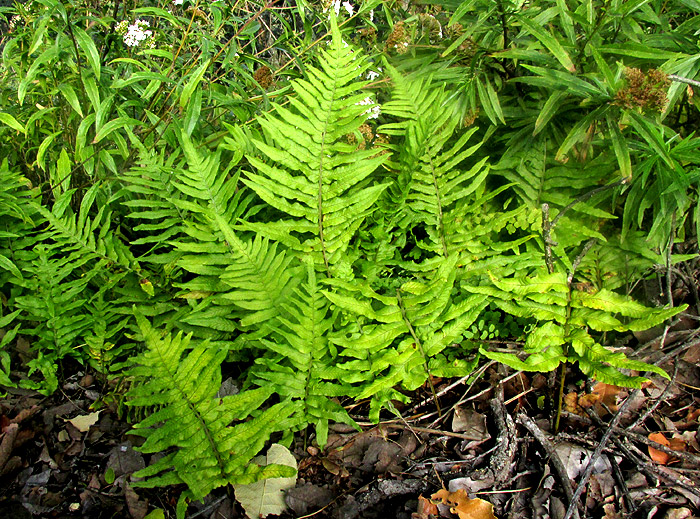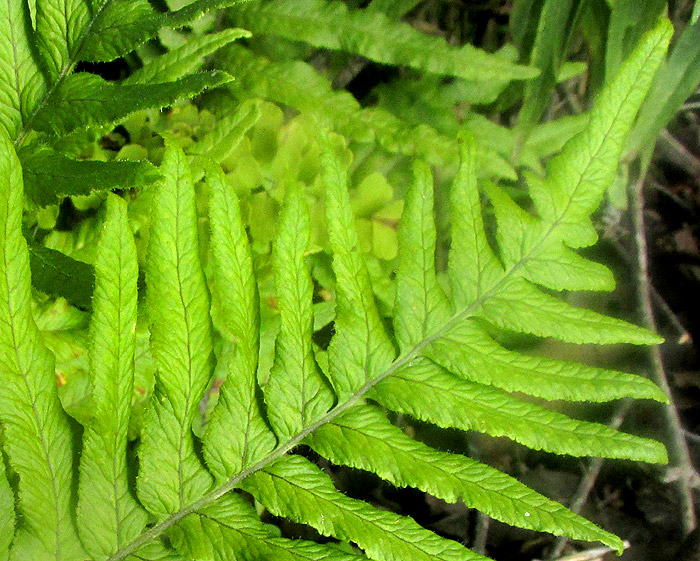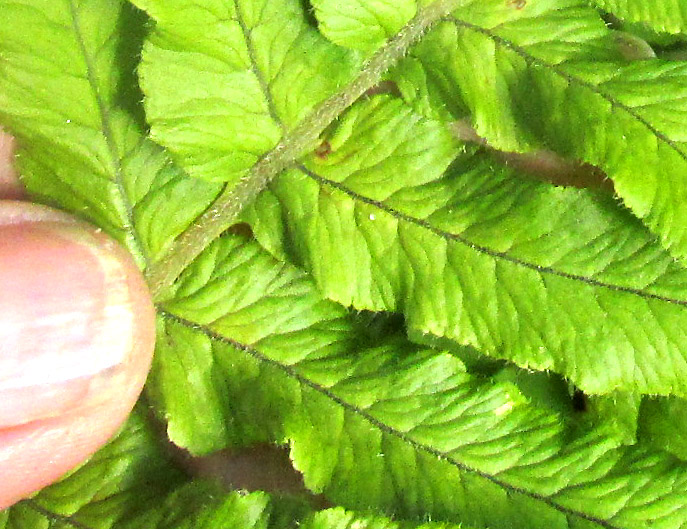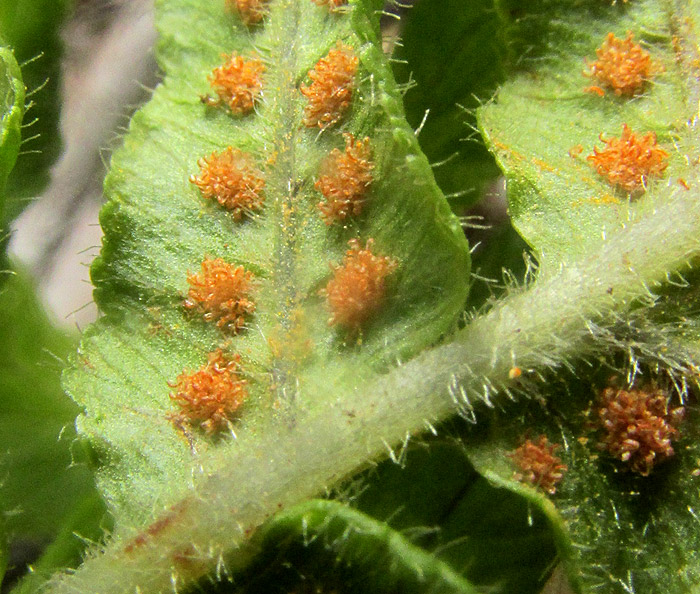Excerpts from Jim Conrad's
Naturalist Newsletter
Entry dated November 8, 2023, from notes taken near Cascadas de La Piedad waterfall 3kms NW of the community of San Pablo, municipality of Almeaco de Bonfil; bedrock of igneous andesite; N20.1021°, W100.0035°, elevation 2360 meters (7750ft); extreme southern Querétaro state, MÉXICO
POLYPODIUM PLESIOSORUM

The above ferns clustered at the eastern edge of a cliff dropping into the canyon about 100m downstream from the Cascada de La Piedad, or Piety Waterfall. Maybe deer had snipped off tops of fronds on the picture's right side.

Later I'd find it hard to identify this fern, and several obscure details had to be noted. For example, it was important to note the shape of the fronds' tips, and that the lobes below the fingerlike tips abruptly become longer as they descended the rachises. Also, note how the veins were somewhat impressed into the frond's surface, and that the lobes' margins were not sharply toothed or spiny, but rather somewhat wavy with very low, rounded projections; they were "crenulate." Even the fern's pale, yellowish-greenness was important to note, for many species are dark green.
A critical field mark for identifying ferns is how the frond is or is not divided into individual leaflets. Above, note that lobe bases are not attached to their own stalks, or petiolules, but rather the lobes' sides descend to form extremely narrow "wings" of green tissue along the rachis sides, connecting the lobe bases. Despite first impressions, at least the top of this frond was "pinnatisect," meaning that it consisted of just one blade pinnately divided almost to the blade's midrib, or rachis, but the blade was not completely separated into individual leaflets, or pinnae. This part of the frond was not compound. But, look at a frond's base:

Here the subdivisions do indeed narrow to their own stalks, so they are pinnae, not lobes. This part of the frond, in contrast to the top, is compound.
Also important was to note that not only were the frond's two lower pairs of pinnae shorter than the pinnae above them, but they tended to project backward a little.

Above, the important feature is that veins arising from the midribs of individual lobes and pinnae branched like a tree as they approached their margins. Also, branch tips do NOT join with other branch tips, as in many species they do. Above you see that the frond's rachis and and the subdivisions' midribs, or costa, are hairy. Later it would be important to know whether the hairs were longer than 1mm or shorter. Ours were shorter, though some came close to 1mm. Internet pictures of this species overwhelmingly portray hairless fronds, but the text of several technical descriptions mention that such hairiness is possible. We may have an exceptionally hairy example of the species.

Above it's seen that this late in the season prodigious numbers of spores already have been released from sori on the fronds' undersurfaces. Within each sorus, each minuscule, capsule-like sporangium rises on a stalk, and running from the stalk to over the top of the spore-bearing capsule is a crestlike "annulus." As the annulus dries, it shrinks, creating a pulling-apart tension on the capsule's surface. At some point the tension breaks open the capsule, scattering spores. Above, most sporangia already have been opened and now consist of just stalks tipped with silvery remains of the capsule walls. The sori's cinnamon color also is a good field mark. Finally, here's the top of the frond's petiole, or stipe:

For identification, it was useful to notice that each stipe has a groove extending down its top side, and inside the groove it's much more densely hairy than outside.
All the above-mentioned features were needed to identify our fern as POLYPODIUM PLESIOSORUM, with no English name. It occurs throughout Mexico's upland forests to about 2600m (8500 ft), south through Central America and possibly to upland northwestern South America.
The 2010 study by María Eugenia Molina-Paniagua entitled "Estudio Florístico del Pedregal de Arócutin, en la Cuenca del Lago de Pátzcuaro, Michoacán, México" lists Polypodium plesiosorum as used medicinally, but no mention is made of how. This is the only reference I can find of our fern being used by humans. The Eurasian Common Common Polypody, of the same genus Polypodium as our fern, is famously employed in traditional medicine and as cooked food, so a good guess is that our Polypodium plesiosorum traditionally also has been useful to humans; just that those uses are not well documented.
Our fern's overly mature sori made the species tricky to identify. When identifying ferns, such mature sori raise the question of whether the young sori had been covered with membranous indusia or not. Often, sori in various species display conspicuous indusia when young, but later the indusia break up, and emptied sporangia completely obscure any indusium's stump. Did our fern's sori really lack indusia, or had the indusia been destroyed and covered over? The question is important, because the Polypody Family to which our fern belongs produces no indusia, while the Wood Fern Family, the Dryopteridaceae, is home to numerous species very similar to our fern, which do.
This touches on the matter that currently the boundaries of the Polypody Family are much debated. The authoritative 2016 Pteridophyte Phylogeny Group separated the Polypody Family from the Wood Fern Family, but at this writing Kew's authoritative Plants of the World database lumps the Wood Fern Family with the Polypody Family.
My impression is that northern botanists unfamiliar with such species as our Polypodium plesiosorum -- which at first looks more like a Wood Fern than a Polypody -- favor keeping the families separate; the lumping concept would produce an "unwieldy megafamily." However, those familiar with species seeming to fit into one family as much as the other, think they should be combined.